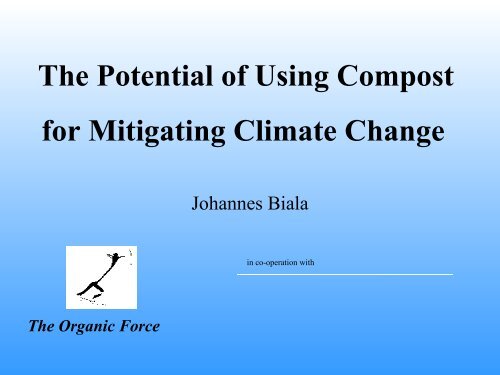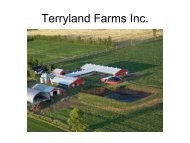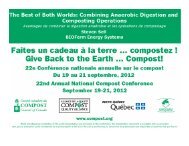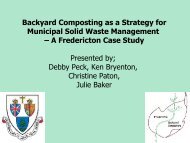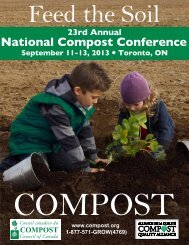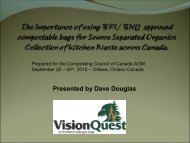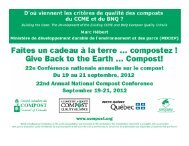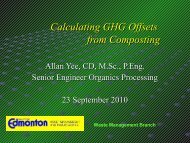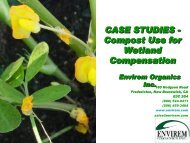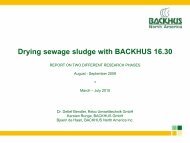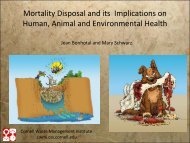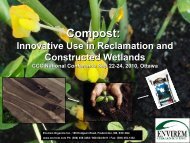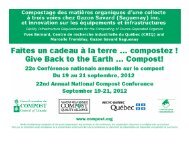Johannes Biala, The Organic Force - Compost Council of Canada
Johannes Biala, The Organic Force - Compost Council of Canada
Johannes Biala, The Organic Force - Compost Council of Canada
Create successful ePaper yourself
Turn your PDF publications into a flip-book with our unique Google optimized e-Paper software.
Potential KeyMitigation Measures1. Enhancing removal <strong>of</strong> atmospheric carbon- Soil carbon sequestration2. Reducing emissions- N 2 O emissions from soil- Methane emissions from soil- GHG emissions from fertiliser production
<strong>Compost</strong>ing –Loss <strong>of</strong> Carbon<strong>Compost</strong>ing <strong>of</strong> manure solidsSource: Inbar et al. 1989 in Epstein 1997
<strong>Compost</strong>ing –Building Stable <strong>Organic</strong>Compounds<strong>Organic</strong> ResiduesTotal <strong>Organic</strong> C(% DM)‘Recalcitrant’Lignin C(% <strong>of</strong> TOC)‘ReadilyDecomposable’ C(% <strong>of</strong> TOC)Farm manures 32 30 70Paper mill sludge 30 20 80Garden organicscompost13 65 35Source: Bhogal et al. 2007
<strong>Compost</strong> Use –Carbon Transformation ContinuesDecomposition <strong>of</strong> composted and uncomposted organic amendmentsExamples Carbon Transformation5.7% TOC in 70 d – tree prunings + yeast composted 25 wks21% TOC in 32 wks – two-phase olive waste composted 34 wks14% TOC in 24 wks – 20 samples <strong>of</strong> manure + plant based composts5% TOC in 60 d – MSW + biosolids compost in 2 soils8% / 14% TOC in 60d – biosolids compost in 2 soils17% TOC in 52 wks – biowaste in mine site rehabilitationLabile organic compounds are degradedSource: Gale et al. 2006
<strong>Compost</strong> Use – Carbon SequestrationUse Use <strong>of</strong> <strong>of</strong> garden & food organics compost at in 55 sites fields over / 2 9 farms / 12 yrs inUK(relative compared to control)<strong>Compost</strong> application (t DM ha -1 yr -1 )Sites with silageAll locationsSource: Davison 2008Source: LTZ 2008<strong>Organic</strong> matter (%)
<strong>Compost</strong> Use - Carbon SequestrationCarbon Sequestration (12 yrs)Increase soil organic matter level (percentage-point)50% TOC - Mature garden organics compost (Site: Trend We)46% TOC – Mature garden + food organics compost (Site: Fo)30% TOC – Pasteurised garden + food organics compost (Site: St)Carbon Addition per 10 t DM ha -1 (avg over 12 yrs)0.82 t C ha -1 yr -1 - Mature garden organics compost0.97 t C ha -1 yr -1 – Mature garden + food organics compost1.13 t C ha -1 yr -1 – Pasteurised garden + food organics compostFor maintaining SOC levels<strong>Organic</strong> matter increasey = 0.012 x OMR 2 = 0.434.8 t DM ha -1 yr -1 - Mature garden organics compost3.8 t DM ha -1 yr -1 – Mature garden + food organics compost2.6 t DM ha -1 yr -1 – Pasteurised garden + food organics compostSource: LTZ 2008Addition <strong>of</strong> compost organic matter (t DM ha -1 )i.e. 8 - 9 t DM ha -1 yr -1= SOM increase by 0.1%
<strong>Compost</strong> Use - Carbon SequestrationPotential SOC increases in UKdue to use <strong>of</strong> organic soil amendments for up to 20 years (Model)<strong>Organic</strong> AmendmentCereal strawIncrease in SOC(kg ha -1 yr -1 t -1 DM applied)50 (20 – 80)C Retained in Topsoil(% <strong>of</strong> applied C)7Manures(and paper sludge)60 (20 – 100)23Biosolids- Digested- Raw180 (130 – 230)130 (90 – 170)5636Garden organics compost60 (40 – 80)43Source: Bhogal et al. 2007
A Simple<strong>Compost</strong> Carbon Sequestration ModelSoil organic matter (%)Source: Favoino & Hogg 2008
<strong>Compost</strong> Use - Carbon SequestrationLong-term & Medium-term Carbon Storage is Important• Assumptions:- Mature garden organics compost- 20 years: 45% compost C sequestered- 50 years: 35% compost C sequestered- 100 years: 10% compost C sequestered• Sequestration:Mature garden organics compost at a rate <strong>of</strong> 10 t DM ha -1will sequester carbon that is equivalent to• 5,046 kg CO 2-e over 20 years• 3,532 kg CO 2-e over 50 years• 1,009 kg CO 2-e over 100 years
<strong>Compost</strong> Use – Reducing Emissions• N 2 O emissions from soilEffects <strong>of</strong> compost use unclear• Methane emissions from soilGenerally not a problemEffects <strong>of</strong> compost use unclear• GHG emissions from fertiliser production- Fertiliser replacement potential <strong>of</strong> compost- Nitrogen mineralisation and plant uptake- Nutrient (P & K) use efficiency
Nitrogen Mineralisation<strong>Compost</strong> / AmendmentType, QuantityCattle manureCattle manure compostManure compost60 t ha -1Durationweeks52Net Mineralisation% <strong>of</strong> N tot or N org12 – 28 (avg 21)N org8 – 12 (avg 11) N org25% N tot34% N totFour manure composts 16 0 - 14% N totManure compost 3211 - 29% N tot
Nitrogen Mineralisation- Generalisations -• Immature compost- temporary nitrogen immobilisation- total nitrogen mineralisation is <strong>of</strong>ten lower than frommature compost (in the short term)• <strong>Compost</strong>ing <strong>of</strong> manure results in markedly reducednitrogen mineralisation• Mineralisation rates range between 5% and 20% <strong>of</strong> addedtotal nitrogen in the most favourable temperature andmoisture conditions• Mineralisation rates are higher in sandy soils than in claysoils
Nitrogen Mineralisation- Mature & Immature <strong>Compost</strong> -Fresh <strong>Compost</strong>Mature <strong>Compost</strong>Cumulative NO3 release as % <strong>of</strong> initial N in compostSource: Chodak et al. 2001DaysDays
Type <strong>of</strong> <strong>Compost</strong>Plant Available Nitrogen (% <strong>of</strong> total N added)NitrogenUse EfficiencySource: Amlinger et al. 20031 st Year 2 nd Year 3 rd Year SubsequentGeneric compost 10 2 - 3 2 - 3 2 - 3Generic compost10 (spring)15 (autumn)Generic compost 10Generic compost < 10Generic compostVarious compostsVarious compostsPot trial0 - 10Field trialFYM compost 11Biowaste compost 1 - 25Biowaste compost 7Biowaste compost 5 - 7Biowaste compost < 52 – 5 2 – 53.5 3.5Total <strong>of</strong> 12% – 20% after eight yearsTrial 1: 2 – 7Trial 2: 1 – 8-19 - +4 (0) -17 - +17 (-3)2 – 53.5Biowaste compost 10 - 150 – 3 (short termBiowaste compost5 – 8 (medium term)> 8 – 10 (long term)Biowaste compost0.3 – 14average over 6 years with annual applications (total average = 7%)Biowaste compost7 – 34 ^Biowaste compost0 – 12.6(avg = 6.1%) ^^Garden organics compost 5 - 10MSW compost 8 5 3 1.5MSW compost 5.3 – 13.2
Nitrogen Use Efficiency• Generally: 5 – 10% uptake <strong>of</strong> added N• < 5% during initial 3 - 4 yrs• 5 – 15% if compost applied > 4 yrs• N use efficiency higher (5 – 25%) if no / littleuse <strong>of</strong> mineral N• N use efficiency higher if used for crops withhigh N demand
Nitrogen Use Efficiency12 yrs = 4 cropping cycles5 t DM ha -1 10 t DM ha -1 20 t DM ha -1n noitropor PCropping cycle (3 yrs each)0% min NegortiSource: Haber et al. 2008
Nitrogen Accumulation & Releaseos det al u mucc AN mineralisation from compost (kg/ha)Application: 8 t DM ha -1 yr -1N content: 1.6% DMN mineralisation: 1. year = 10%; 2. year = 4%; subsequent = 2%YearsYearsnliSource: Amlinger et al. 2003rti
Nutrient & Carbon Content (kg/t DM)<strong>Compost</strong> Type(Source)Garden organics(Wilkinson et al. 2000)Garden organicsGarden organics blended(Chan et al. 2007)Garden organics blended(Paulin et al. 2005)Garden organics(Bhogal et al. 2007)*Biowaste & garden organics(BGK 2009)Biowaste(Linzner et al. 2005)CountryNo <strong>of</strong>SamplesNitrogen(N)Phosphorous(P)Potassium(K)Carbon(C)Australia 33 - 47 8.80 1.80 5.33 324Australia(Sydneyregion)Australia(Perth)UnitedKingdom101210.0012.101.603.805.004.4025120618 - 21 14.30 7.69 5.81 306?Typical10.70 1.88 6.77 214Germany 5,422 14.00 2.92 9.63 225Austria(Vienna)Average**2001-03Nutrient & carbon concentration, as well as fertiliserreplacement rate (% <strong>of</strong> total) used for calculations17.80 2.92 10.54 24411.00(40%)2.00(100%)5.50(100%)275
GHG Emissions Fertiliser ProductionType <strong>of</strong> Fertiliser Specification Emissions(kg CO 2 -e t -1 nutrient)Nitrogen FertiliserAmmoniaEurope 1,402 – 2,638<strong>Canada</strong> & USA 1,492 – 1,951Ammonium NitrateCalcium Ammonium NitrateUreaUrea Ammonium NitratePhosphorous FertiliserSingle SuperphosphateTriple SuperphosphateAustralia 1,524 – 2,195Europe - average 6,537 – 7,109Europe – modern technology 2,985Europe - average 6,810 – 9,563Europe – modern technology 3,019Europe - average 1,326 – 4,019Europe – modern technology 913Europe - average 3,668 – 5,763Europe – modern technology 2,000Europe - average 41 – 459Europe – modern technology -104Europe - average 154 – 473Europe – modern technology -182
GHG Emission Savings fromFertiliser ReplacementNutrientelementNutrientcontent(kg t -1 DM)Crop uptakeFertilisernutrientsreplaced(kg t -1 DM)Fertiliser GHGemissions(kg CO2-e t -1 )Avoided GHGemissions(kg CO2-e t -1DM compost)Garden organics compostNitrogen (N) 11 40% 4.4 3,500 15.4Phosphorous (P) 2 100% 2.0 350 0.7Potassium (K) 5.5 100% 5.5 300 1.7Total 17.8
Potential GHG Mitigationthrough <strong>Compost</strong> Use• Assumption:continuous use <strong>of</strong> 10 t DM ha -1 mature gardenorganics compost• Sequestration:Time frameGHG mitigation (kg CO 2 -e)Soil carbon sequestration Fertiliser replacement Combined20 years 5,046 178 5,22450 years 3,532 178 3,710100 years 1,009 178 1,187
Having these largelyEuropean-based Datais Good,but not Good Enoughto Make a Difference in Australia1. Adjust data to reflect Australian conditions2. Incorporate compost use into AustralianNational Carbon Accounting System (NCAS)3. Introduce the concept and use <strong>of</strong>‘Humus Budget’
Introducing ‘Humus Budget’as Soil & Farm Management ToolHumus loss Humus replenishment Humus budget+ = Re-branding away from ‘carbon’ Potential to link with farm nutrient budgetsSource: Siebert, 2008
Example <strong>of</strong>Humus Budget for Crop RotationCropSugar beetWinter wheatWinter wheatTotalkg Humus-C / ha-760 to -1,300 kg-280 to -400 kg-280 to -400 kg-1,320 to - 2,100 kgImports<strong>Compost</strong> (25 t DM in 3 yr)Balance (3 years)2,600 kg500 - 1,280 kgSource: Siebert, 2008
- Summary –<strong>Compost</strong> Use …• won’t save the world, but….• Can contribute to mitigating climate change• Can help open a window <strong>of</strong> opportunity (20 – 30years) to find other means (technologies) <strong>of</strong>reducing / mitigating emissions• Is one <strong>of</strong> the fastest means <strong>of</strong> improving soilcarbon levels• Is ideally suited as mitigation measure inproductive agricultural soils• Fits easily into Australian NCAS• Can attract carbon credits
Never Forget:<strong>Compost</strong> is much more than Carbon!SoilCarbonSoil QualityAggregation &InfiltrationWater &NutrientHoldingProductivityAir & WaterQuality;Wildlife HabitatSource: USDA NRCSTime
www.compost-for-horticulture.com


